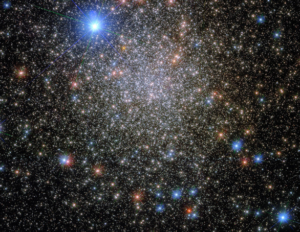Look Up! Featured Activity – Improv with the Stars

This content was written by Christine Shupla from the Lunar and Planetary Institute
Celebrate the first images of NASA’s new James Webb Space Telescope with this featured activity: Improv with the Stars
After learning about four stellar classifications and the characteristics of stars, groups of patrons act out an improvisation of the “personality” of the four stars while the audience gets to guess which star type is which.
Facilitate as an in-person program at your library inside or outside. Consider pairing this with the Life Cycle of a Massive Star activity.
Time to complete: one hour
Ages: 10 to 16 years old
Modification and Preparation List
Total Cost: $0 (some limited printing)
Fundamental Space Science Concepts – Improv with the Stars relates to this Space Telescope’s First Images:

This photo shows a cluster of stars, with many different colors and brightnesses.
The new Space Telescope will observe a variety of stars, and particularly will be able to peek inside the giant clouds of gas and dust (or nebulae) where clusters of stars are born. Libraries can use this activity, along with the bookmark activity, to engage patrons in exploring the different types of stars and how their mass relates to their color, temperature, and lifespan.
These stellar nurseries form stars with different masses (varying amounts of gas). The amount of gas that makes up a star sets the rate for the reactions that form energy at the center of the star. The most massive stars generate an enormous amount of energy, which results in very hot stars, about 20,000° Fahrenheit on the outside. Smaller stars with less mass don’t generate as much energy and light and are much cooler (only a few thousand degrees Fahrenheit on the outside). Our own Sun is almost 10,000° F.
Just like the different parts of a fire are different colors, with hottest bluish flames and redder cooler flames, stars are different colors depending on the temperature of their outer layers. These colors and temperatures were labeled with different letters before we understood these properties, so the letters are not in order of color or temperature: O (blue), B (blue-white), A (white), F (white-yellow), G (yellow), K (orange-red), and M (red). Our Sun is a G-type star. For most of a star’s life, the temperature of the outer layers of a star are directly related to its mass. The most massive stars have the most energy, are the hottest, and are blue (O and B type stars). The least massive stars have the least energy, are the coolest, and are red (K and M type stars).
Stars change or evolve over their lifespans. As stars run out of the hydrogen that fuels their energy production in their cores, they expand, like a marshmallow in the microwave. As they do, their outer layers cool off and become redder. Smaller stars expand into red giants. Large blue stars eventually become red supergiants. Blue stars end their lives after millions of years in enormous explosions—supernovae! Our Sun will become a red giant and at the end of its life will blow away most of its gas, leaving behind a hot dense core known as a white dwarf. Because of their slower reaction rate, the smallest stars that formed over 13 billion years ago are still around!
Resources for you to use and share with patrons:
Think Tank: A Star Is Born and Think Tank: When Stars Go Boom!
These 3-minute videos describe how stars form and shine, and how the most massive stars end their lives. Both videos are appropriate for patrons of all ages.
Launchpad: Life Cycle of a Star
This 6-minute video takes a closer look at the life cycles of stars to examine where stars come from, how they change, and what happens to stars when their lives come to an end.
Learning Physics: Types of Stars by Size, Color, and Life Cycle
This 6-minute video describes the relationships between a star’s size, color, and life cycle. While the language and visuals are great for children, some concepts are more appropriate for patrons ages 12 and up.
Forms of Light: Omega Centauri
This interactive shows an aging cluster of stars in different wavelengths of light.
Discover more activities in the Look Up! First Image Clearinghouse Collection




Responses